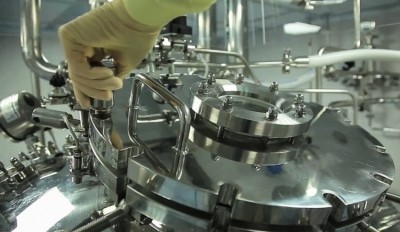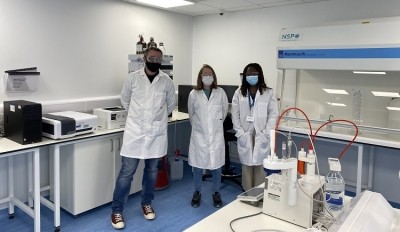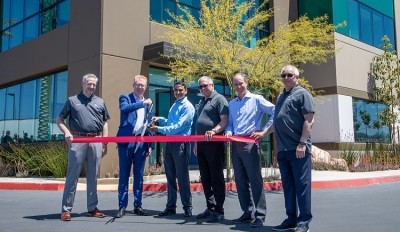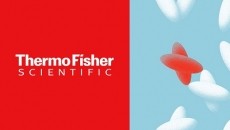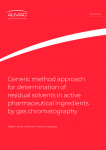Grand River Aseptic Manufacturing tackles unique expansion

Founded in 2010 to fill an increasing need for outsourced sterile injectable manufacturing, Grand River Aseptic Manufacturing delivers high-quality fill and finish services for parenteral drug products. A sharp increase in demand motivated leadership to look at expansion options, and the company landed upon a unique approach to growing its Grand Rapids, Michigan facilities.
Rather than the traditional approach of doing design first and construction second, they worked in close collaboration with construction firm CRB in a more parallel way, designers staying several steps ahead of their construction colleagues.
The novel approach on the two-year greenfield expansion increased the company’s capacity by four times; features of the two-story include a high-speed Bausch+Ströbel filling line, SKAN isolators, IMA lyophilizer auto-loader, support equipment, and QC laboratory. Outsourcing-Pharma (OSP) spoke with representatives from Grand River Aseptic Manufacturing (GRAM) and CRB about the unique project.
OSP: Could you talk about the market demands and client needs that might have impacted GRAM’s growth?
GRAM: Market demands and client needs have been the driving factor behind our rapid growth. With increased client demands, we understood we need to expand quickly while providing the same customer-minded service that has always set us apart. Client demands combined with a growing need for US-based facilities in the pharmaceutical market made us confident investing in our facility expansion.
With a decade of experience, our size has been an advantage allowing GRAM to stay flexible and agile. Our newly opened large-scale fill and finish facility incorporates flexible equipment that increases GRAM’s capabilities and capacity to serve a growing number of commercial clients.
OSP: Please tell us about the features of the new building, and how the specific features expand your services and/or add to your list of capabilities.
GRAM: Designing and building a pharmaceutical manufacturing facility from the ground up gave GRAM the opportunity to incorporate top-of-the-line equipment that works seamlessly together. The combination of modern equipment, advanced technology and facility automation give us the flexibility to serve multiple clients on the best equipment in our industry.
GRAM has a decade of experience that is supported by talented staff. When you build a solid foundation and give experienced staff the ability to use their skillsets in a new facility like GRAM’s, it leaves the door open for future expansion; GRAM strategically left 14,000 square feet available in our facility for just that - expanding our capabilities to fill client needs. The design of the facility also took into consideration the utility requirements for future expansion.
OSP: Could you please tell us about the specialized considerations (structural, systems, etc) that a specialized facility like GRAM’s new facility have that you wouldn’t have to think about on a more conventional building, such as an office complex, mixed-use retail, restaurant, etc.
GRAM: The facility was designed around a unique footprint of land as well as a state-of-the-art filler/isolator system that had already been purchased by GRAM. The utilities were also designed to meet the needs of the specialized manufacturing processes at GRAM; these utilities that aren’t typical at most facilities are clean compressed air, clean room space air, nitrogen, water for injection and pure steam.
CRB: The facility includes several specialized components to support the pharmaceutical manufacturing systems, associated cleanroom spaces and quality assurance laboratories. Utility systems were designed and constructed to maintain reliability, highly stringent environmental parameters and flexibility in operations and future expansion. The structural systems and exterior envelope are constructed to provide enhanced stability and to minimize any potential disruption to the manufacturing systems.
OSP: The approach to design and construction on this structure also was innovative—could you talk a little bit about that?
CRB: GRAM approached CRB with a very challenging project, including a tight timeline and difficult constraints. CRB’s ONEsolution approach enabled the project team to optimize the entire delivery and phasing of the project, allowing procurement, detailed planning and construction to begin months earlier than otherwise possible, yielding ultimately a lower cost and shorter delivery.
Additionally, through close collaboration and enhanced planning with the GRAM team, operational turn-over, validation and equipment start-up began months earlier than otherwise possible – allowing GRAM to bring the facility online quickly.
GRAM: Design and construction were completed in phases; for example, civil and structural design was completed and then construction began. While construction on civil and structural were ongoing we were finalizing design on mechanical, electrical, plumbing, and other phases.
This process was used through the entire project to start construction as soon as possible to meet the desired schedule. This also required dedicated resources from all vendors, CRB and GRAM to work together as a cohesive team to make decisions daily to meet long lead time purchases and construction schedule.
OSP: Aside from what makes a pharma-centric facility like this different, could you tell us what sets the GRAM expansion facility apart from other life-sciences buildings CRB might have worked on?
CRB: The GRAM facility utilized many components and system common to the life sciences industry; however the GRAM and CRB teams worked together to integrate these systems into a state-of-the-art and highly efficient design. GRAM was able to maximize the facility to the greatest extent, given some challenging constraints.
